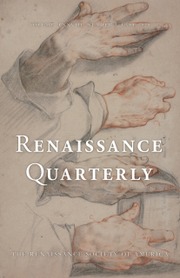Marilyn Migiel’s latest work on the Renaissance poet and courtesan Veronica Franco is an in-depth study of the first fourteen poems (of the twenty-five in total) of the Terze rime published under Franco’s name in 1575. Together these poems represent a series of exchanges between the poet and an unnamed male author. Migiel’s project is a recuperation of Franco’s poetic voice that does not solely privilege what has been the prevailing narrative of her “outspoken polemicism and her embrace of sexuality” (9). The thrust of her argument does not hinge primarily on biographic and historical details but rather sees “the potential for multiple narratives that emerge in tension with each other” (21) after sustained and philologically sound close readings of the text.
The author prefaces her work with the desire “to understand how Franco constructs her identity as author, lover, and sex worker” (4), a goal that simultaneously brings her into dialogue with the scholarly tradition on the subject. Migiel is both deferent and critical of previous scholarship by “highlighting the consequences of embracing her as a feminist icon” (162), and through this process, she positions herself both within and against a solely feminist reading of Franco’s poetry that imperils a fuller and more complete picture of her poetic identity. Her thorough analysis demonstrates her preoccupation with challenging any overarching narrative that gives way to misinterpretations and ambiguities that have arisen in the long history of the scholarship on Franco. Throughout the text, she demonstrates her exhaustive knowledge of not only the poetic tradition, both classical and early modern, but also the scholarly tradition that she cites authoritatively in the presentation of her argument. Migiel’s monograph engages the reader to participate in the very dialogic process that it seeks to explore as it evokes our own personal histories in the analysis.
Migiel identifies Ovidian, Dantesque, and Petrarchan allusions throughout the dialogic exchanges that coalesce around Franco and her male interlocutor. Franco uses these allusions to mythological figures as a strategy of ambiguity, figuring herself simultaneously both like and unlike figures such as Orpheus, Ariadne, Niobe, Byblis, and Apollo. According to Migiel, the destabilization of these evocations presents interstitial spaces in which subject positions become overlaid with one another such that “she is like Orpheus and not like him; she is both an active agent and a subject who is acted upon” (50). She posits that it is precisely from these ambiguities that the force of Veronica Franco’s power comes into being.
Migiel is at her best when she engages in an analysis of the prosody of both sets of poetic exchanges. Her philological methodology enriches her reading of Franco’s ability to contrast her poetic identity against her male addressee, to whom she grants no less sustained attention than she does to Franco herself. In chapter 5, “Seductive Insinuation and Obliquely Frank Refusal: Terze rime 9 and 10,” Migiel shows how the male author seeks to possess Franco by insinuating himself into her interior space through his metrically unsettling enjambment and his willingness to break the versification rules of the day. She speculates that “a man willing to break with expectations about versification is a man who might well break other boundaries” (101). Franco capitalizes on his metrical and poetic failures by turning his verses against him in sets of binary oppositions that highlight the tension of obliqueness and frankness that she deploys in order to manage her persistent lover.
Migiel concludes the monograph where she begins, by asking what we truly see in Veronica Franco’s poetry—a question that she answers: “by beginning her Terze rime with the dialogic poems, Franco creates a foil against which she can craft her image of herself as neither condescending or haughty but still the equal or better than most of her male interlocutors” (164). Migiel has demonstrated that a deeper and more reflective exploration of Franco’s poetry yields a more complex narrative of the woman who has been labeled a feminist of her age. What truly remains is a figure whose often tentative and indirect responses reveal a woman who was an astute judge of character as well as of her times.


